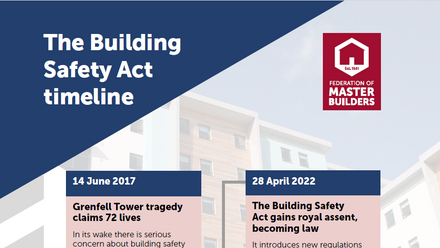The Building Safety Act 2022 and small business
The driving force behind introduction of the Building Safety Act 2022 was the need to reform health and safety rules around tall buildings – driven by an urgent call to review fire safety measures in the wake of the Grenfell Tower tragedy.
However, parts of the new law relating to high-rise ‘High Risk Buildings’ have only just come into force in October 2023. As a small or medium sized (SME) building company, you may not work on this type of building and it can be difficult to see how the new law applies to you.
We consulted with contruction law expert, Gavin Hoccom of legal firm Browne Jacobson, who explained which aspects of the Act might apply to SMEs, and how you should be taking steps to protect your business.
Why should small builders pay attention?
There’s a common misconception that the Building Safety Act only affects those who construct, design or own higher risk buildings, or those who are involved in cladding works. In fact, the act impacts anyone who employs or is employed to carry out building works to commercial or residential property, regardless of the scale of work carried out. This includes:
- Newbuilds
- Redevelopments
- Refurbishment
The changes that were introduced in October 2023 brought 'Higher Risk' buildings under the scope of the Building Safety Act. The changes have increased the list of dutyholders responsible for building safety on building projects, regardness of the size of the build, and place a greater emphasis on documenting building safety, particularly for Higher Risk Buildings. To find out what Higher Risk Buildings are and for more information on the changes, take a look at our previous blog about the Building Safety Act here.
As well as builders and contractors, the list of construction professionals this applies to includes:
- Contractors
- Tradespeople
- Architects
- Surveyors
- Building product manufacturers and suppliers
- Owners and occupiers of Higher Risk Buildings
A new Building Safety Regulator
The Act has introduced a new Building Safety Regulator, which sits within the Health and Safety Executive (HSE). The regulator oversees the safety and performance of all buildings and is responsible for prosecuting non-compliance.
The BSA brought Building Act 1984 back into force, which will make it easier for people to make claims against companies who don’t comply with building regulations. Section 38 of the Act gives private individuals the right to claim damages from builders for work that’s not compliant with building regulations. This can be done at present though a contractual process, meaning the claims from the builder they have a contract with, who in turn can then claim from any subcontractors responsible for the failure. But Section 38 of the Act cuts out the need for a contract and claims can be made directly against subcontractors – cutting out the middle man'.
Critically, a claim can also be made within 15 years of any work completed after Section 38 came into force in June 2022.
Civil liability claims
With the Building Safety Act, extensions and refurbishments now fall within the scope of civil liability under section 2A of the Defective Premises Act 1972, which sets out a duty to complete work in a professional manner with proper materials so that the dwelling is fit for habitation.
Again, this is regardless of contractual terms or the type of work. This applies not only to the person who originally commissioned the work but also subsequent owners of the property.
Claims can also be brought within 15 years if breach of duty occurred after April 2022, but if the breach relates to the construction or conversion of dwellings only (ie, not including refurbishment) the period is 30 years.
This means that claims can be raised for breaches that happened before April 2022. So, individuals can now claim under the Defective Premises Act for breaches that occurred as far back as 1992.
If you are an SME builder, it’s clear there is a pressing need to review current and historic projects involving dwellings and to collate and store any evidence for the long term.
New Homes Warranties
If you are a housebuilder, offering a New Homes Warranty to new homebuyers is now a legislative requirement and there are penalties for non-compliance.
A New Homes Ombudsman Service has been set up to aid in disputes regarding new homes. The Act makes registering for the New Homes Quality Code of Practice a legal requirement, which the Ombudsman have powers to police.
It’s vital to register with the ombudsman scheme and understand its working, including the code of practice.
The Act implements the use of Building Liability Orders – which impose liabilities on associated corporate bodies. This can see liability orders being brought against associated successor companies where the original company that completed the work has become insolvent.
What should SME builders do next?
Action list for SMEs:
- Conduct a review of all current and historic projects as a matter of priority;
- put a process in place to document evidence of compliance with Building Regulations for the long term;
- ensure you have adequate Professional Indemnity Insurance, and offer New Homes Warranties if you build homes;
- review corporate structuring – who ensures compliance with Building Regulations and notices from the Regulator; and
- be aware of ‘pre-employer’ contract terms when negotiating building contracts.
Visit the CIOB website to find out more about the Building Safety Act.
Find guidance from the Building Safety Regulator on the HSE’s website.




